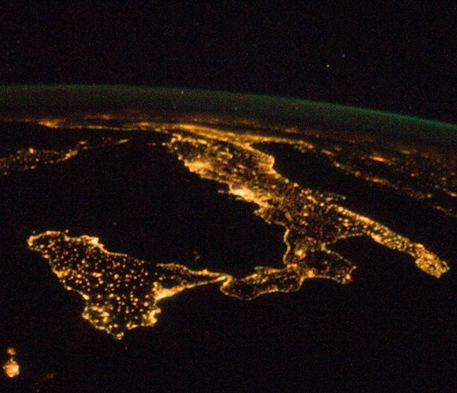The Italian peninsula as seen from space
This photograph (see full photo
here) was taken from the international satellite in orbit 240 miles above the earth. The glow of lights in the center of the western coast of Italy is Naples, the glow of lights to its north is Rome.
 Comments
Comments
Buck writes:
That’s a beautiful image. It’s also ironic. We’re looking down from our newly accessible night skies to enjoy the spectacular views that we can now only infrequently enjoy by looking up from Earth. In our urban centers it’s much worse, but in general, wherever we are, it’s said that modern man is down forever to a still diminishing seventy percent visibility of our historically spectacular night sky. The light that makes the satellite image of Italy so beautiful is light pollution that may forever obscure man’s view into the natural beauty of the once taken for granted beautiful night sky above.
Thomas Bertenneau writes:
This image represents the heart of the West. The early Romans referred to Southern italy as Magna Graecia, or “Greater Greece,” because its dominant people were the citizens of the Greek colonies there. Sicily too was culturally Greek. These regions were many centuries later receptive and hospitable to Christianity, which crept northward along the Italian boot from the lower extremities. The Greek light and the Christian light traveled the same path, and now it is visible from orbit, as Plato imagined in the Timeaus.
Vincent Chiarello writes:
I cannot resist adding to the comments made about Naples, and the city’s striking illumination in the photo taken from high above the Earth.
For anyone to visit the city, which was called by its original Hellenic rulers, “Neopolis,” or the “New City,” is to see an urban center that has been slowly decaying for decades, largely forgotten by the governments that rule from Rome. It is now heavily influenced by organized crime, not the Mafia of Sicilian origins, but the Camorra, whose tentacles now reach out further into the world than their Sicilian counterparts. A Neapolitan journalist, Roberto Saviano, wrote an account of the Camorra’s influence several years ago, and to this day is under police protection.
Perhaps it is dumb luck that has made me walk the mean streets of Napoli without fear; something I would not do in our nation’s dysfunctional capital. I cannot say that I could serve as a tourist guide to the city, but I know enough about it to know the good restaurants and pizza places, as well as to find the best lemon ices one could possibly imagine. For within this city, divided by what is called, “spacca Napoli” (divided Naples), is to encounter people who sing as they speak, and in my opinion, one of the loveliest and most impressive churches in all of Italy: Santa Chiara.
In a film made during the last months of his life, called Io Ricordo (I Remember), the Italian actor, Marcello Mastroianni, truly the handsomest man that ever appeared on the silver screen, sits on a chair along the rocky beach in Naples describing his life and his rise to stardom. When asked what is his favorite Italian city, Mastroianni, born near Rome, doesn’t hesitate in responding: Naples. Why? Because he says, of all the major Italian cities Naples is still the most authentically Italian, not having been influenced or changed by the hordes of tourists that engulf the other cities of the peninsula.
Perhaps it is that tie to its past that makes Naples glow from the heavens above, for it is that attraction that in an earlier time produced my most favored description of that city of the Magna Graecia: Vedi Napoli e muori—See Naples and die.
Posted by Lawrence Auster at September 09, 2012 03:10 PM | Send
